Bitcoin's breakthrough of $100,000 seems just around the corner, and the community is eagerly anticipating the development of the Bitcoin ecosystem.
Although the performance of related ecosystem tokens has not been particularly impressive, U.S. compliant trading platforms such as Coinbase and Kraken have recently issued cbBTC and KBTC, respectively. Industry giants have never paused their exploration of the Bitcoin ecosystem. Compared to other chains or its own nearly $2 trillion market cap, the Bitcoin ecosystem has a long way to go, but it also holds enormous development opportunities.
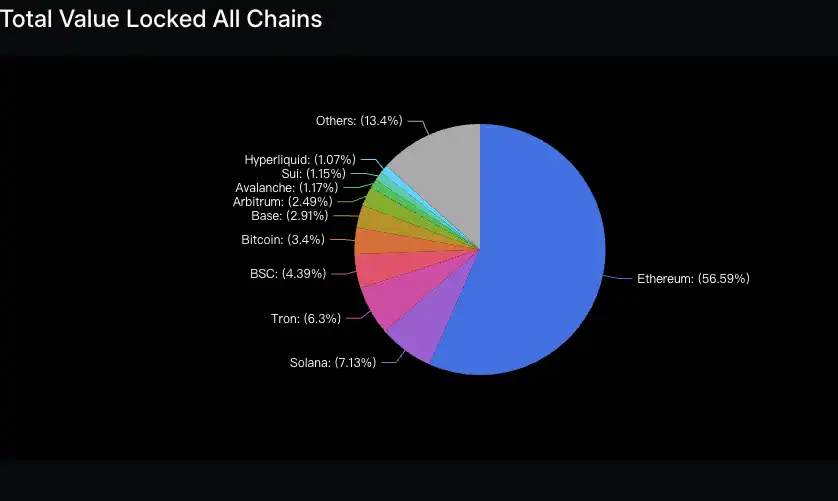
The percentage of total TVL occupied by each chain, with the Bitcoin ecosystem accounting for only 3.4%
From the perspective of the secondary market, there has always been a demand for track rotation and switching from high to low positions. In the Bitcoin ecosystem, Stacks stands out as a leader in this field, and its iterative journey has become the best representation of the exploration of the Bitcoin ecosystem. Stacks has continuously built its technology and ecosystem from scratch, which is particularly solid and impressive in the current market environment.
Recently, the case between Ripple and the SEC has reached a temporary conclusion, and the resignation of the SEC chairman has triggered a super bull market for XRP. Like Ripple, Stacks is also a representative of compliance in the crypto industry. In July 2024, the U.S. Securities and Exchange Commission (SEC) terminated its investigation into Stacks and Hiro. Moreover, Stacks is the first token issuance project ever approved by the SEC.
The Technological Iteration Journey of Stacks
The Dream of Smart Contracts on Bitcoin: From Blockstack to Stacks
The history of Stacks can be traced back to Blockstack, founded in 2013 by Muneeb Ali and Ryan Shea from Princeton. Blockstack, as the initial v1 version, aimed to create a decentralized internet ecosystem using a distributed computing network, fully replacing traditional cloud computing. At that time, Blockstack hosted a large number of DApps.
By 2021, Blockstack's v2 version, the Stacks mainnet, was officially launched. At this point, the team's goal underwent a significant shift—from serving a decentralized internet to empowering Bitcoin. Through the Stacks protocol, developers can build applications with smart contract functionality on the Bitcoin network without modifying Bitcoin itself. In this process, Stacks inevitably faced criticism from Bitcoin "maximalists," but Muneeb has consistently persevered in conveying the vision of Stacks to the community.
PoX and Clarity: Deep Integration of Bitcoin and Stacks
Stacks can safely integrate with Bitcoin thanks to its innovative Proof of Transfer (PoX) consensus mechanism. The core idea of the PoX mechanism is to allow miners to participate in Stacks block mining by transferring Bitcoin, rather than relying on computationally intensive competition. This way, Stacks not only inherits the security of the Bitcoin network but also allows Bitcoin holders to become direct participants in the ecosystem.
Compared to traditional Proof of Stake (PoS), the design philosophy of PoX aligns more closely with Bitcoin's decentralized spirit. It uniquely transfers the value of Bitcoin into the Stacks ecosystem, creating a tight economic bond between the two. For miners, the PoX mechanism provides a new way to capture value, while for developers, this deep integration gives them greater confidence in implementing smart contracts on the Bitcoin network.
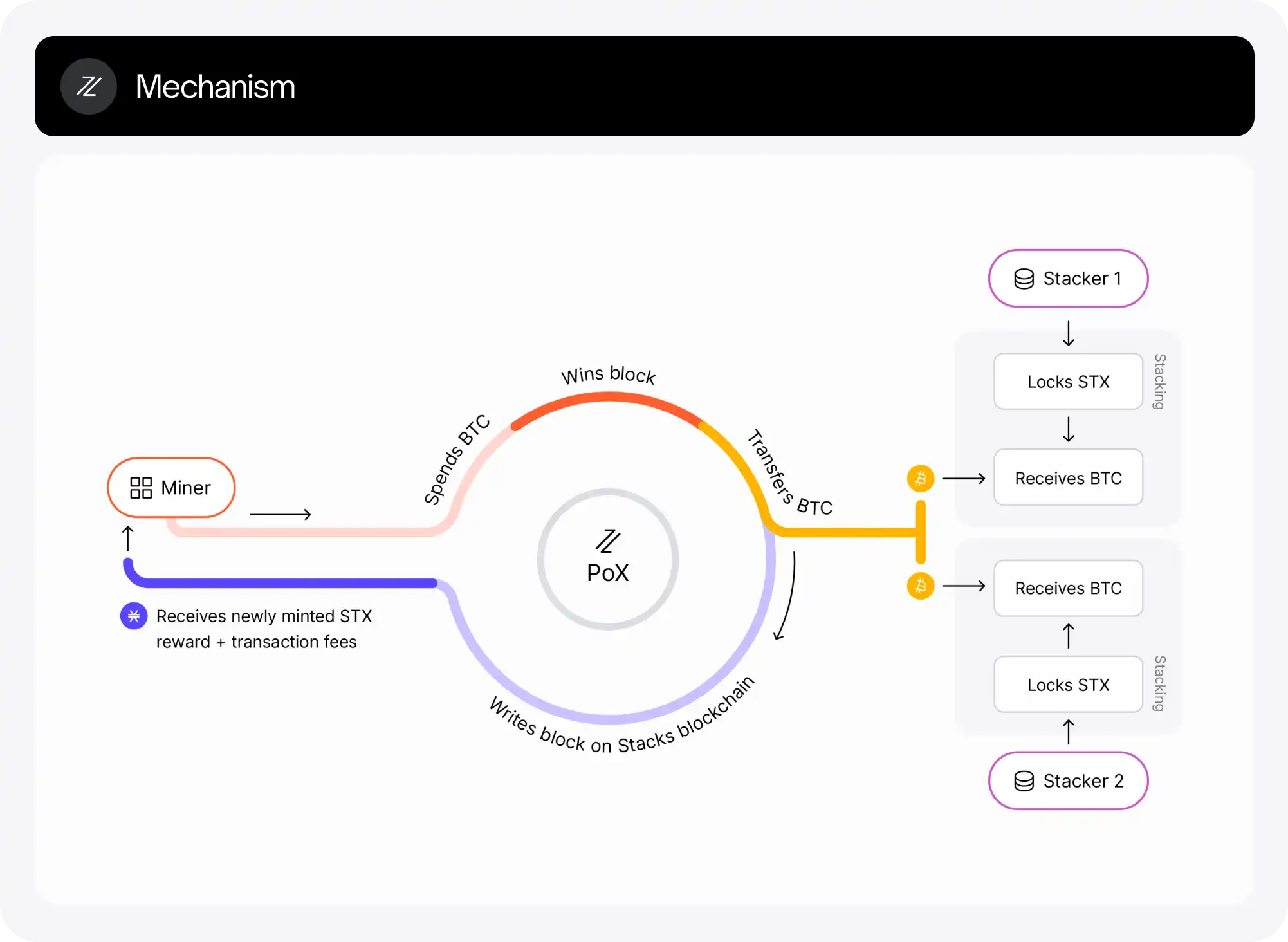
Alongside the launch of the Stacks mainnet, a smart contract language specifically designed for Bitcoin, Clarity, was introduced. Clarity is a non-Turing complete language, meaning it focuses on implementing verifiable functions while avoiding uncertainties in complex computations. When developers use Clarity, they can preview the execution results of smart contracts in advance, significantly reducing the risk of unexpected behaviors. Additionally, Clarity runs directly on-chain, avoiding vulnerabilities that traditional smart contract compilers might introduce. This language, designed specifically for Bitcoin, lays the foundation for DeFi, NFTs, and other complex applications.
Nakamoto Upgrade: Faster, More Stable, and More Secure
Just as there is no perfect code, Stacks also has room for improvement in expanding Bitcoin.
The initial design of Stacks tied block production to Bitcoin's block production. This resulted in high latency due to slow block production, and even micro-blocks could not completely resolve the issue. At the same time, the security of the Stacks network was not fully bound to Bitcoin, as the cost of reorganizing the last N blocks in the Stacks blockchain was lower than the cost of generating the next N + 1 Stacks blocks, making it easier to attack Stacks compared to Bitcoin.
In light of this, Stacks launched the "Nakamoto Upgrade" in 2024, which was officially completed on October 29. The significance of this upgrade is not only a technical optimization but also a key step towards the prosperity of the Bitcoin ecosystem.
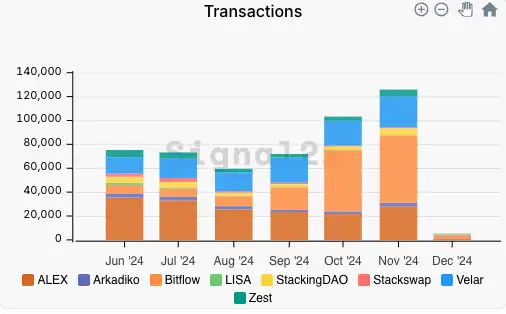
In November, the number of on-chain transactions for Stacks reached a recent high
Fast Block Confirmation: Optimizing User Experience
The Nakamoto upgrade introduced a fast block confirmation mechanism, allowing users to achieve near real-time transaction confirmations on Stacks. Micro-blocks and Bitcoin anchor blocks will be eliminated, replaced by continuously produced Stacks blocks, allowing miners to produce multiple blocks during a single Bitcoin block period, significantly enhancing transaction speed.
The time required for user-submitted transactions to be confirmed is no longer 10 to 40 minutes but only about 5 seconds, improving network efficiency and opening doors for high-frequency trading and instant payment scenarios.
Bidirectional Verification: Enhancing Security
After the upgrade, Stacks adopted a bidirectional verification mechanism, requiring miners to remain active on both the Bitcoin and Stacks networks. This design increases the security of the network while ensuring the collaborative relationship between the two chains. For attackers, altering Stacks data would require controlling the consensus of the Bitcoin network simultaneously, significantly raising the cost. This upgrade also addressed the MEV issue by modifying the cryptographic selection algorithm, ensuring that Bitcoin miners cannot gain unfair block rewards due to their advantages. It increased the cost for Bitcoin miners to participate in Stacks mining, requiring them to invest resources comparable to other miners.
sBTC and the Stacks Ecosystem: Unlocking Bitcoin's Potential
Following the completion of the Nakamoto upgrade, the sBTC, which was announced in the 2023 roadmap, will also be launched as scheduled. According to the latest news, the testnet phase of sBTC has been completed, and the mainnet launch will be divided into three phases:
The first phase (expected to launch on December 16, 2024): Introduces the functionality for users to deposit BTC and mint sBTC, with early depositors eligible to participate in the sBTC reward program.
The second phase (expected to launch 6-8 weeks after the first phase, between February 1 and 15, 2025): Unlocks the sBTC withdrawal function, allowing users to exchange sBTC for BTC.
The third phase (specific timing to be determined): Opens the signer set, gradually forming a fully decentralized, open, and permissionless signer network.
The Design and Working Mechanism of sBTC
The core of sBTC lies in its decentralized design, avoiding the trust risks associated with traditional centralized custodial solutions. Through a Dynamic Signer Group, sBTC ensures the security and transparency of the exchange process between Bitcoin and sBTC. After users lock BTC on the Bitcoin network, they can generate an equivalent amount of sBTC on the Stacks chain. When redemption is needed, users destroy sBTC to release the corresponding amount of BTC. This process is entirely managed by smart contracts, ensuring transparency and security in operations. sBTC has an elite signer network that includes industry leaders such as Blockdaemon, Kiln, Luganodes, Copper, and Figment.
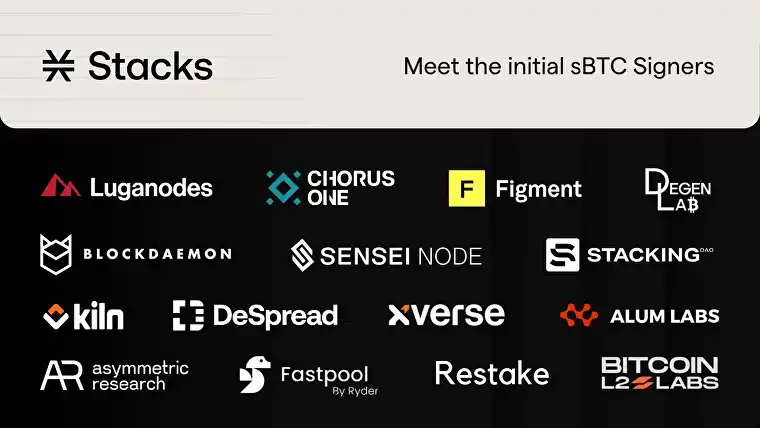
Advantages and Innovations of sBTC
The design of sBTC incorporates multiple innovations, showcasing significant advantages. First, it employs a dynamic signer group for management, completely avoiding the risks that traditional centralized custodial solutions may pose, aligning closely with the decentralized philosophy advocated by Bitcoin. Second, sBTC grants programmability to Bitcoin, enabling seamless interaction with smart contracts on Stacks. Furthermore, all operations of sBTC are executed through Clarity smart contracts, ensuring that users can transparently understand every process and status. This transparency not only reduces trust costs but also further enhances operational security, providing users with greater assurance.
The Impact of sBTC on the Stacks Ecosystem
Recently, wBTC has faced community skepticism. BA Labs proposed in August to lower the liquidation threshold of wBTC to 0% in Sky (formerly MakerDAO), but after discussions with BitGo, they decided to indefinitely suspend this divestment plan. Recently, Coinbase decided to delist wBTC. Perhaps due to these events, the TVL of wBTC has decreased from 152,000 BTC in August to 136,000 BTC now.
As mentioned above, the early stages of sBTC still have incentive programs. Perhaps sBTC can rely on both internal and external forces to not only fill the existing market gap for BTC on-chain but also attract more native Bitcoin into the L2 and DeFi fields, injecting strong vitality into the Stacks ecosystem. sBTC grants Bitcoin programmability, enabling it to participate in various DeFi applications, including decentralized lending, yield farming, and synthetic asset trading, greatly enriching the diversity of the Stacks ecosystem. Additionally, sBTC provides developers with new opportunities to build complex applications on the Bitcoin network, sparking a surge of innovative ideas and further driving the rapid development of the Stacks ecosystem. Through sBTC, Bitcoin has successfully transformed from a single value storage tool into a programmable asset.
New Developments in the Stacks Ecosystem
Coinflip, a global leader in Bitcoin ATM operations, announced its integration with Stacks, planning to support sBTC to enhance Bitcoin's programmability and accessibility. sBTC will also be launched on the Aptos Network and Solana to further strengthen Bitcoin's role in the evolving cross-chain DeFi ecosystem. Through Stacks' Best & Brightest initiative, Immunefi announced a collaboration with Asymmetric Research and Bitcoin L2 Labs, aiming to enhance the security of sBTC through the upcoming "Attackathon" hackathon event, facilitating seamless transfers between the Bitcoin main chain and Stacks.
The Bitcoin accelerator Bitcoin Frontier Fund (BFF) announced plans to invest in teams building projects using sBTC, while the lending protocol Zest on the Stacks chain also announced this year that it completed investments from Tim Draper, Binance Labs, Bitcoin Frontier Fund, and Flow Traders.
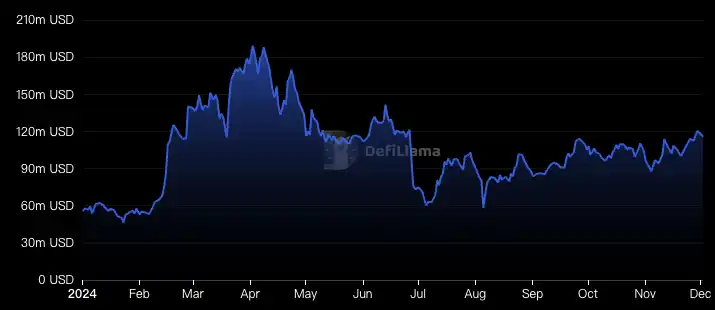
In 2024, the TVL of the Stacks ecosystem has also seen significant growth, primarily supported by the liquid staking protocol StackingDAO, DEX ALEX, and the lending platform Zest. In addition to the aforementioned well-known projects, the Stacks ecosystem also includes the over-collateralized stablecoin protocol Arkadiko, the domain platform .locker, tools for DAO organizations like Console, the NFT platform Gamma, the Bitcoin-supported payment system GoSats, and Skullcoin, which brings on-chain gaming to Stacks. Not only existing projects, but the number of Bitcoin projects also set a record at the recent Harvard hackathon co-hosted by EasyA and Stacks.
With the gradual rollout of sBTC, the Stacks ecosystem will welcome more innovations and developments. In the future, Stacks plans to further optimize network performance, reduce transaction costs, and increase throughput to attract more developers and users, creating a comprehensive Bitcoin smart contract ecosystem. Through collaboration with other blockchain networks, Stacks and sBTC are expected to achieve widespread adoption globally, promoting the prosperous development of the Bitcoin ecosystem.
免责声明:本文章仅代表作者个人观点,不代表本平台的立场和观点。本文章仅供信息分享,不构成对任何人的任何投资建议。用户与作者之间的任何争议,与本平台无关。如网页中刊载的文章或图片涉及侵权,请提供相关的权利证明和身份证明发送邮件到support@aicoin.com,本平台相关工作人员将会进行核查。




